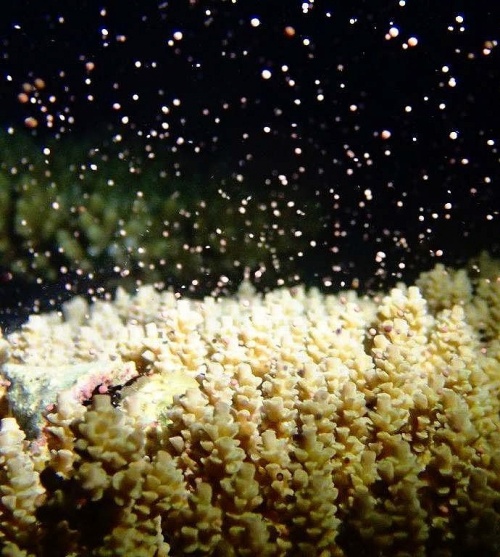OIST scientist proposes new theory on limited migration of coral reefs in Okinawa

Acropora coral synchronized sprawling. In June 2015 (Photograph provided by OIST)
December 11, 2015 Ryukyu Shimpo
On December 10, Chuya Shinzato of the Okinawa Institute of Science and Technology Graduate University (OIST) Marine Genomics Unit announced the results of research into the coral genetic information of coral reefs found in the Ryukyu Archipelago. The result shows the limited migration of corals in the ocean through the supply of larvae.
Coral larvae have been known to free float in the ocean and expand a coral’s habitat. However, the new theory proposes a limited coral migration over a long time frame. The results will draw attention to finding new ways for coral reef protection, which has so far been focused on the protection of coral larvae.
A part of this research project has been sponsored by the Okinawa Prefecture Coral Reef Conservation and Restoration Project. And researcher Shinzato held a press conference at the Okinawa Prefectural Government to announce the findings. The results were electronically published in Scientific Reports by the Nature Publishing Group on December 10.

OIST researcher Chuya Shinzato
According to Shinzato, coral larvae were known to free float in the Kuroshio current and expand their habitats. If the number of corals decreases in one area, coral larvae would be carried from other areas by the ocean current and would help to recover and revive the corals in the depleted area.
For this research, a type of coral, Acropora digitifera, was collected from the sea around Okinawa south, central, and north, the Kerama Islands, Ishigaki Island and Iriomote Island. OIST researchers analyzed the genome of 155 samples and compared single nucleotide polymorphisms (SNPs), which shows individual variations.
The analysis showed the corals’ SNPs corresponded closely to the areas in which they were collected, which could be divided into four groups: the Okinawa Islands, the Kerama Islands, Yaeyema-North and Yaeyama South. Within each coral cluster was a similar genome DNA, indicating rare migration and reproduction from and to another cluster. From this, researcher Shinzato concluded the new theory of a limited migration of coral larvae.
Shinzato pointed out, “It takes a lot of time to recover corals once construction and climate change damage them. It is important to protect not only the coral-rich areas but also the entire area of the Ryukyu Archipelago.”
(English translation by T&CT and Megumi Chibana)
Previous Article:Over 30,000 letters supporting Okinawa Governor Onaga
Next Article:Arrests of US service members for drunk driving rise 45%
[Similar Articles]
- OIST’s researchers establish technique to identify individual coral by DNA profiling
- Do corals form clouds? University of Tokyo and OIST researchers decode Acropora genome, hope to elucidate environmental adaptability
- Kerama Islands to be designated as a national park
- Dr. Gruss to be the next president of OIST Graduate University
- OIST to build an experiment facility for marine life at Seragaki Fishing Port
 Webcam(Kokusai Street)
Webcam(Kokusai Street)


